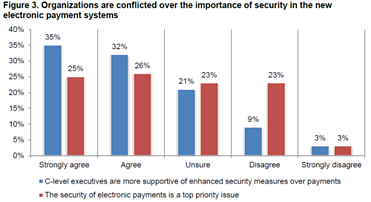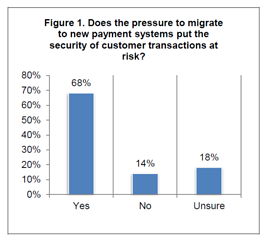
Emerging Payment Technologies: Are they worth it?
The payment processing industry has seen many developments in technology and security since its early days. In the past 50 years or so, we’ve watched the processing of credit and debit cards evolve from a manual process requiring clunky equipment and long processing times, to transactions that can happen in a matter of minutes and require no physical handing off of information from a customer to another human. While continuous technology upgrades have continued to offer more convenience and faster transactions, they’ve also often offered new opportunities for hackers and thieves to access personal and financial data.
In 2014, there were a number of high profile consumer data breaches that left retailers, banks, processors, and their consumers wondering just how safe electronic transactions could really be. However, these incidents also left many organizations worried and hoping to find ways to ensure the safety of their consumers, and the safety of their business without turning away from the latest in emerging payment technology.
Technology Development Won’t Slow Down
Most everyone knows that there’s really no period of time when technology will “stop changing”. Since the 1950s, when credit cards were first introduced, the payment processing industry has evolved from telephone communications for verbal authorization to transactions that happen with just the tap of a button on a smart phone. In that time, payment processing and POS providers have been through iteration after iteration of
 "Data Security in the Evolving Payments Ecosystem" by Ponemon Institute LLC
"Data Security in the Evolving Payments Ecosystem" by Ponemon Institute LLC
hardware and software combinations that facilitate these exchanges of currency. Today, you can find thousands of options for devices and programs that will process electronic payments.
Just as fast as developers and engineers are building the latest in payment processing and data technology, there are fraudsters working to find new ways to compromise the information of unsuspecting consumers and organizations. Accessing, using, and selling the sensitive information of the public has become pretty big business around the world and with the amount these criminals stand to gain from getting their hands on this data, their attempts won’t stop anytime soon.
Companies Are Feeling the Pressure
Today, consumers are adapting to the newest in payment processing technologies that offer them more convenience and better visibility and control. Touch screen tablets, user-friendly kiosks, contactless payments, and EMV chip and pin cards are just some of the industry’s newest technologies. As developments like mobile wallets and portable point of sale devices become the “norm” for today’s consumers., organizations around the world are under a great deal of pressure to stay up-to-date.
This push for new, convenient methods of submitting payments is also causing some amount of anxiety within companies that aren’t sure of the security. In a study sponsored by Experian, 68% of IT professionals from various organizations believed “pressure to migrate to new payment systems puts customer data at risk.”1
 "Data Security in the Evolving Payments Ecosystem" by Ponemon Institute LLC
"Data Security in the Evolving Payments Ecosystem" by Ponemon Institute LLC
Unfortunately, this lack of confidence just isn’t enough for business owners to miss out on newer, convenient technology that will help their businesses run smoothly and keep consumers coming back. In Experian’s study, only 24 percent of the respondents agreed that the importance of enhanced security outweighs the cost of implementing new payment methods.1 In short, businesses are more than willing to invest in newer technology, often despite the potential risks.
Customers Don’t Know How Vulnerable They Are
Many consumers are unaware of the ways that their card and other personal data ends up in the hands of criminals. While the public is generally familiar with the concept of identity theft and possible vulnerability that comes with unprotected systems, they typically are not well-versed in the different levels of security with various types of technology. This lack of education amongst consumers leads them to formulate opinions of payment technology without truly understanding which technology is protecting their information and what may be compromising it.
When the EMV chip and pin card technology standards took effect in the United States, not many people truly understood the purpose and not many companies took the time to educate consumers. When surveyed, 89.4% of U.S. consumers new about the shift before it happened, yet 56% still did not know what an EMV chip card was.2 This unfamiliarity with EMV technology was also apparent in the business realm, as many retailers have been late adopters to the new payment processing terminals and procedures. Several business owners expressed that they did not believe there was a serious need to upgrade their technology to accommodate EMV.
These kinds of misunderstandings around technology changes and the consequences of either making a change, or not, often leave organizations and their consumers oblivious to threats that may still exist. The goal of today’s businesses, whether a payment processing provider or merchant, should be to maintain their intelligence of emerging technology and continue to pass that knowledge along.
Weighing All Options Is Key
Before any company decides to implement changes or updates to their payment technology, they should understand all of the various options and what benefits or risks come with each one. Staying informed about the payment industry’s advancements allows organizations to analyze technological needs, consumer preferences, and even potential security risks. With the right education, businesses and their consumers can avoid thousands (possibly millions) of dollars in damage from hackers and thieves.
Maintaining a working knowledge of the payment industry’s emerging technologies allows organizations to plan and execute new implementation and upgrades with care and ease. The organizations that prioritize innovative technology and top-notch cyber security practices position themselves to not only avoid the devastation of breaches, but also to continue gaining consumer trust.
Being aware of possible options for payment processing hardware and software combinations allows your company to plan for not only implementation, but also potential threats. Of course, no one wants to think about having their payments and data systems compromised, but actually having a plan for such an emergency is much better than being blind-sided.
Innovation is necessary to keep businesses thriving and our world advancing. Emerging technologies in the payment processing industry are allowing companies all over the world to improve their business operations and even capture and store consumer information in new ways. These new opportunities are opening doors for connections and communication like we’ve never seen before. Businesses and consumers should not have to live in fear that utilizing today’s latest technology is going to leave them defenseless to cyber criminals. However, with the proper procedures and planning in place, no one really has to live with an overwhelming amount of fear.
Sources:
- Ponemon Institute LLC. (2015) Data Security in the Evolving Payments Ecosystem. http://www.experian.com/assets/data-breach/white-papers/experian-data-security-payments-ecosystem-2015.pdf
- Woodward, K. (2015) Consumers Know EMV Is Comin, They’re Just Not Sure What It’s All About. Digital Transactions. http://www.digitaltransactions.net/news/story/Consumers-Know-EMV-Is-Coming_-They_re-Just-Not-Sure-What-It_s-All-About
in Industry News, Security, Best Practices
